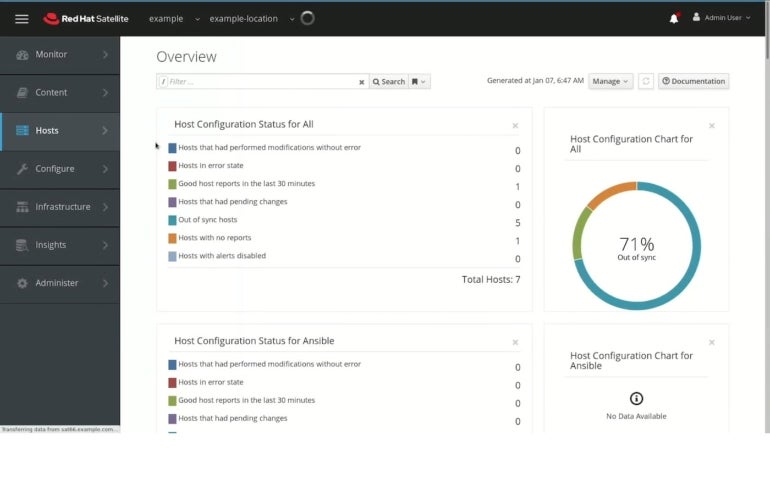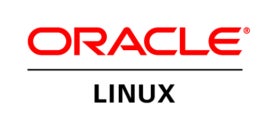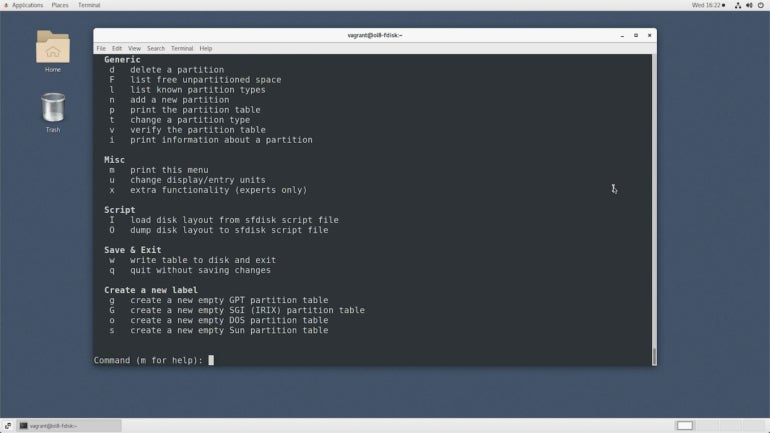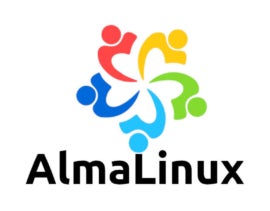- Best for large enterprises: Red Hat Enterprise Linux
- Best for IT and software development companies: Oracle Linux
- Best for die-hard CentOS fans: Rocky Linux
- Best for those familiar with CentOS: AlmaLinux
- Best for programming and rolling release distribution: Fedora
CentOS Linux 7, the popular free and open-source Linux distribution based on Red Hat Enterprise Linux, has set its end of life for June 2024. The enterprise operating system, loved by scientists, businesses and developers for its reliability, stability and security, has been a leading technology for web hosting, cloud computing, storage servers, networks and software development.
As users consider whether to migrate to CentOS Stream 9, a new upstream distribution that is designed to be a rolling release of Red Hat Enterprise Linux and is not considered a replacement for CentOS, other competitors stand out as good alternatives.
Top CentOS alternatives: Comparison table
In the following chart, we note how five CentOS alternatives compare in terms of performance, migration tools and resources, security and compliance, supported architectures, support and lifecycle, and pricing.
Featured Partners: Cybersecurity Software
| Performance | Migration tools and resources | Security and compliance | Supported architectures | Support and lifecycle | Pricing | |
|---|---|---|---|---|---|---|
| Red Hat Enterprise Linux | Highly reliable and robust. | Yes. | Yes, built-in and automated tools. | x86, ARM, IBM Power, IBM Z, IBM LinuxONE and more. | 24-7 support is free with the paid plan. 10-year lifecycle. Upgrade extensions available. | Pricing starts at $179. |
| Oracle Linux | Advanced performance and reliability. | Yes. | Yes, built-in tools. | x86 (32-bit), x86-64 (64-bit) and aarch64 (64-bit). | 24-7 support must be purchased. 10-year lifecycle. Upgrade extension available. | Free to download, use and distribute. Paid versions include Oracle Linux support, Oracle Cloud and Oracle. |
| Rocky Linux | Reliable but under intense development. | Yes, but requires advanced knowledge. | Yes, but requires advanced knowledge. | x86-64-v2, ARM64, ppc64le and s390x. | Community support and commercial support available. 10-year support and upgrade cycle. | Free to download, use and distribute. |
| AlmaLinux | Enterprise-grade but under development. | Yes, but requires advanced knowledge. | Yes, but requires advanced knowledge. | x86_64, aarch64, ppc64le and s390x. | Free community support. Upgrades and year-support lifecycle vary depending on versions. | Free to download, use and distribute. |
| Fedora | Enterprise- grade, reliable and secure. | Yes, built-in advanced features. | Yes, built-in, advanced features. | x86-64, ARM, PowerPC: PowerPC64 and PowerPC64le, s390x and RISC-V: F. | Forums, documents, bug programs, mailing lists and chat support. Supports upgrade from one version to the next. | Free to download, use and distribute. |
What are the best CentOS alternatives?
Since the IBM-owned company decided to restrict the free use of Red Hat Enterprise Linux, a divide has been growing among users. The main question is whether to migrate to commercial Linux providers or open-source, non-commercial community-developed enterprise operating systems.
In this complex landscape of imminent migration, some top names stand out as CentOS’s top alternatives: Red Hat Enterprise Linux, Oracle Linux, Rocky Linux, AlmaLinux and Fedora.
Red Hat Enterprise Linux: Best for large enterprises

The first name that emerges as an alternative to CentOS is naturally Red Hat Enterprise Linux, as it’s the open-source operating system on which CentOS is based. Therefore, many users think that going directly to the source is naturally a good idea, and they’re not wrong.
RHEL has gained its reputation among big enterprises for providing a modern, security-oriented OS. Companies with advanced digital resources, technology stacks and workloads use the OS to scale and perform on-premises, on virtual machines or containers and in the cloud. The OS is certified on hundreds of clouds and with thousands of hardware and software vendors.
Figure A

Features
- Stability and community support: RHEL is a very stable OS designed to be used in mission-critical environments. There is also a large and active community of RHEL users and developers to offer support.
- Security: Security is at the core of RHEL. The system includes a great number of advanced security features.
- Official support and benefits: Red Hat provides 24/7 support for RHEL, and all versions have a 10-year life cycle. Plus, Red Hat connects users with its extensive hardware, software and cloud partner ecosystem.
- Supported architectures: It runs on servers and workstations, and supports a wide range of hardware architectures like x86, ARM, IBM Power, IBM Z and IBM LinuxONE.
- Automation and management: The OS includes Red Hat Insights, a managed service for analytics and remediation that delivers continuous vulnerability alerts and guidance.
- Security and compliance: RHEL can simplify risks and automate security and compliance with built-in features like live kernel patching, security profiles, security standards certification and a trusted software supply chain.
- Migration: From installing to migrating or updating, the vendor offers tools to streamline the processes, whether users are coming from CentOS Linux or another OS.
Pros
- Stable and reliable software.
- High-performing security and compliance.
- Well-supported OS.
- Wide range of features.
- Large and active community.
Cons
- Not free; commercial pricing can be expensive for small companies.
- Can be complex to manage.
- Not as flexible as some other Linux distributions.
Pricing
RHEL variants include the Server edition and RHEL Workstations, which are optimized to run on high-performance workstations. Additionally, other versions are Linux for Virtual Datacenters, Linux for IBM Power Little Endian and Linux for SAP Solutions.
Pricing starts at $179 for the Workstation, and the most expensive solution, Linux Virtual Datacenters, starts at $2,499.
SEE: For more information, read Red Hat Enterprise Linux 9.
Oracle Linux: Best for IT and software development companies

Oracle Linux is another solid alternative for those looking to migrate from CentOS for several reasons. First of all, Oracle Linux is 100% Red Hat Enterprise Linux compatible. It can handle a wide variety of workloads, heavy-duty databases, application servers and DevOps. Additionally, users can migrate from CentOS to Oracle Linux seamlessly using built-in migration features. And, they will benefit from several features that are not available in CentOS.
Fully compatible with RHEL, Oracle offers a choice of two kernels: the Unbreakable Enterprise Kernel for Oracle Linux or the Red Hat Compatible Kernel.
- The Unbreakable Enterprise Kernel provides the latest open source innovations, key optimizations and security with a focus on performance, stability and minimal backports by tracking the mainline source code as closely as is practical. It is a Linux kernel built by Oracle and supported through Oracle Linux support. UEK is designed for maximum performance and stability and drives Oracle Cloud and Oracle Engineered Systems, such as Oracle Exadata Database Machine. UEK is well-tested and used to run Oracle’s Engineered Systems, Oracle Cloud Infrastructure and large enterprise deployments for Oracle customers.
- The Red Hat Compatible Kernel is for Oracle Linux, and it is compatible with the Red Hat Enterprise Linux kernel; this means that software that is compiled for RHEL will also run on Oracle Linux with RHCK.
Oracle Linux is a good choice for businesses and organizations that need a stable, reliable and secure operating system. It is also popular among IT and software companies because of the features listed below.
Figure B

Features
- Migration: Oracle provides a quick and easy migration path to switch from CentOS Linux or other OS. The company also offers hands-on labs and tutorials to help users throughout the process.
- DevOps automation: IT companies and software developers leverage the automated DevOps features to accelerate production and deployment. Through these features, Constellation Research users can find five drivers for DevOps automation, recommendations and more.
- Multi-environment performance and reliability: Oracle Linux is designed to support x86 and Arm architectures across on-premises, multicloud and edge environments. It is also engineered for heavy workloads.
- Security and compliance: Users can apply security vulnerability fixes without downtime. Oracle Linux can help users detect exploits and use a distribution that has FIPS and Common Criteria certifications to meet compliance.
- Official support: Oracle Linux support must be purchased. The price for the 24/7 support starts at $499 per year.
Additional features that are not available in CentOS include:
- Zero-downtime patching with Ksplice.
- Cloud-native tools such as Kubernetes and Kata Containers.
- Kernel-based virtual machine virtualization and oVirt-based virtualization manager.
- Gluster Storage for Oracle Linux.
- The Btrfs file system (only available with UEK).
- DTrace dynamic tracing framework (only available with UEK).
- Oracle Linux Automation Manager and Automation Engine.
- Oracle Linux Manager utility to assist in patching and errata management.
Pros
- Offers free download, use and distribution.
- Boasts high-performance, stability, security and reliability.
- Provides automation for DevOps.
- Delivers superb support.
- Offers a wide range of features that CentOS does not.
- Includes a 100% RHEL compatible migration path for CentOS and other OS users.
Cons
- Support must be purchased.
- Can be complex to manage.
- Compliance features require advanced knowledge.
Pricing
Oracle Linux basic version is free to download, use and distribute; this includes free source code and updates. The Oracle Cloud Infrastructure pricing can be estimated online and the Linux Support plan pricing is available upon request.
SEE: Is Oracle Linux a valid replacement for CentOS? (TechRepublic)
Rocky Linux: Best for die-hard CentOS fans

Rocky Linux is a community-supported Linux distribution that was created when CentOS announced its end-of-life cycle. The project is led by the original founder of CentOS, Gregory Kurtzer.
The OS is designed to be a drop-in replacement for CentOS. It responds to the needs of the CentOS community and has received support from Amazon Web Services, Google Cloud, VMware, Open Source Lab and others.
Rocky Linux is an open-source enterprise operating system designed to be 100% bug-for-bug compatible with Red Hat Enterprise Linux; however, as it is under intensive development by the community, it is not yet risk-free.
Figure C

Features
- Migration: Rocky Linux offers support and guides for users to use when migrating from CentOS, CentOS Stream, Alma Linux, RHEL or Oracle Linux. Advanced skills are required for the migration and what Rocky Linux calls “a mildly risk-taking attitude.” A migration script is available free of charge.
- Production-ready: Despite it still being under development, the OS is enterprise-ready and provides solid stability with regular updates.
- Community support: The OS has the support of well-known CentOS leaders, as well as the wider community.
- CentOS features: The OS provides all the main CentOS features that developers and the community are familiar with, making the learning curve a straight line.
SEE: Learn to use Linux for IT and Sysadmin with this training bundle (TechRepublic Academy)
Pros
- Free and open-source.
- Reliable and secure.
- Well-supported.
- Excellent for users familiarized with CentOS.
- Supported by the CentOS active community.
Cons
- Under intense development.
- Not risk-free.
- Requires advanced knowledge.
Pricing
Rocky Linux is free and provides free upgrades along with a 10-year support lifecycle, all at no cost.
AlmaLinux: Best for those familiar with CentOS

AlmaLinux is another forked version of CentOS, owned and governed by a community of developers. Like RockyLinux, the OS began development when CentOS announced it would no longer offer support or release new versions.
The community behind AlmaLinux assures that the OS will always be free for enterprises, and that they are focused on long-term stability and a robust production-grade platform. The company adopted a Fedora-like distribution for anyone who does not want to pay for RHEL licenses. AlmaLinux is supported by CloudLinux Inc. and other sponsors.
Features
- Migration: AlmaLinux does not have built-in automated step-by-step technology that guides users through migration. AlmaLinux does offer guides, but only those with advanced skills will be able to follow them (Figure D).
- Production-ready: AlmaLinux OS is an enterprise-grade server OS. It is a stable Linux distribution and offers regular releases and support. It is designed for critical workloads. The organization provides official images for cloud providers including AWS, generic clouds, Google Cloud, Microsoft Azure, OpenNebula and Oracle Cloud Infrastructure.
- Community support: The AlmaLinux GitHub organization contains source code and tools used to build AlmaLinux OS and related infrastructure. The Reddit community is in place for users to receive updates and find and provide support. Additionally, other community forums are available.
- Supported architectures: AlmaLinux supports four architectures: x86_64, aarch64, ppc64le and s390x.
- Performance and security: AlmaLinux is a very stable operating system that relies on the expertise of experts in the community. It is designed to be used in mission-critical environments, and it has a long history of reliability. It also provides a number of security features, which include SELinux and AppArmor.
Figure D

Pros
- Open-source and free.
- Migration support.
- High-grade enterprise distribution OS.
- CentOS-style features.
- Large community support.
Cons
- New to the market.
- Not risk-free.
- Requires advanced knowledge.
- Advanced tools such as automation and compliance may vary and depend on the level of user expertise.
Pricing
AlmaLinux is free. Upgrades and support provided vary depending on the version.
Fedora: Best for programming and rolling release distribution

Fedora is an innovative platform loved by programmers because it provides cutting-edge technology, is reliable and stable, and is a free and open-source OS packed with features.
Fedora is also a community-supported Linux distribution developed by Red Hat. In concept, it compares more to CentOS Stream than to CentOS because it offers rolling release distribution, giving users access to the latest technology. New features and updates are released on a continuous basis. The new features in Fedora are available before they are released in Red Hat Enterprise Linux. Fedora also invests heavily in graphic user experience and provides easy-to-use, high-quality graphics through modern desktops (Figure E).
Figure E

Features
- Versions: Fedora is available in Workstation and Server versions as well as for IoT, Cloud and as a Container optimized OS. Each version is updated for approximately 13 months; upgrades between versions are quick and easy.
- Performance: With Fedora Server, users can run virtual machines and containers, build applications, deploy a server and workloads, and create stable ecosystems.
- Support: Provides issue tracking, chat support, resources, documentation, community support and more.
- Rolling releases: Fedora is a rolling release distribution, which means new features and updates are released on a continuous basis. Users have access to the latest software available.
- Supported architectures: x86-64, ARM, PowerPC: PowerPC64 and PowerPC64le, s390x and RISC-V: F.
Pros
- Free and open source.
- Built-in migration tools and resources.
- Cutting-edge operating system, offers rolling releases.
- Community supported.
Cons
- Advanced skills are required.
- Setup can be complex.
Pricing
Fedora is free and provides free upgrades from version to version.
Is CentOS still relevant?
CentOS is still a relevant Linux distribution despite it being on the countdown for its end of life. You could think of CentOS as a very good car that the manufacturer is no longer producing. While you can still use the car and it works perfectly, you will not receive upgrades, new versions or support. In the near future, it is expected to become outdated.
Will there be a CentOS 9?
No, there will not be a CentOS 9. Red Hat announced it would no longer support CentOS as a downstream distribution of RHEL. This means there will be no new versions of CentOS released after CentOS 8.
However, led by a large community and supported by commercial partners, forks of CentOS such as Rocky Linus and AlmaLinux are being developed. These forks are designed to be 100% compatible with CentOS, so they can be used as a drop-in replacement for CentOS.
Is CentOS good in 2023?
While CentOS in 2023 is still a good option, developers and businesses are already looking into migrating to other alternatives.
Having said that, CentOS is still stable, reliable and compatible with a wide range of software in 2023. It is also still free and open-source, and has the support of an active community of users and developers. However, due to the end of CentOS as we know it, it may not be the best choice for everyone in 2023 and beyond.
What is the future of CentOS?
While the future of CentOS is uncertain, the most likely scenario is that one of the organizations developing forks of it becomes the go-to OS for this community by mid-2024 when it reaches its end of life.
On the other side, from Red Hat’s perspective, the future of CentOS is CentOS Stream, which is a new Linux distribution developed by Red Hat, an IBM-owned company. But CentOS Stream is not a replacement for CentOS — it is a different distribution with a completely different focus. It aims to be at the forefront of development by offering users rolling release distribution to test new features and updates before they are released in RHEL. In this way, it is similar to Fedora; also, both are developed by Red Hat, and both offer rolling releases.
How do I choose the best CentOS alternative for my business?
There is no easy answer to this question. When choosing an alternative for CentOS, business leaders should consult with their developers to learn which OS they feel more comfortable with because they will be the ones operating the system.
On the other hand, budget may be a deciding factor, especially for small companies. Additionally, among CentOS users and developers, there is a strong sense of community, support and respect for free open-source projects. Therefore, even if a company has the budget to buy the most expensive licenses, developers may feel more confident and comfortable working with open-source, free technology.
Some users may see the end of life of CentOS as an opportunity to migrate to another OS such as Oracle Linux or Red Hat Enterprise Linux. These more conservative choices offer features that CentOS does not offer.
In the end, the OS you choose must align with your business needs and goals, be flexible, reliable and secure, and provide excellent migration and support. Scaling, automation, upgrades and compliance are also key components to analyze.
Conclusion
CentOS has provided vital services for organizations, companies and developers for many years. While the OS faces the inevitable end of its glory days, there are still solid new and established Linux OS distributions in the market.
From CentOS-inspired community OSs like Rocky Linux or AlmaLinux, to a cutting-edge OS like Fedora, or the big names of Oracle and Red Hat Linux, the options are as diverse as they are rich. It will be up to every business to decide which Linux distribution fits their operational needs.
Methodology
To write our review and evaluate CentOS competitors and alternatives, we examined sites that compile aggregate data based on verified user reviews. We also reviewed demos on vendor sites, test-drove the software when possible and scoured through the official sites of all OS providers’ features in this report to evaluate their software, customer service, user-friendliness, price, scalability and more.





